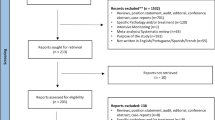Abstract
Purpose
To assess the effect of a small economic inducement on the rate of spontaneous reporting of adverse drug reactions (ADRs) and the attitudes of general practitioners and physicians towards reporting of ADRs.
Method
One intervention and one control county were selected for the study. Written information about the main purpose of spontaneous reporting of ADRs was personally addressed to all physicians in the two counties. The information was identical, except for the addition that during a period of 6 months two lottery tickets would be given to the receivers in the intervention area with the standard personal feedback to the reporter of the ADR. After the 6-month study period, the actual number of reported ADRs and the seriousness of the reported ADRs were assessed. To investigate the attitude towards this stimulation of reporting, a questionnaire was addressed to all physicians within the intervention area (IA).
Results
From the IA a total number of 57 ADR reports were received containing 62 suspected ADRs, 40% of which were assessed as serious reactions. From the control area (CA), 49 reports containing 50 suspected ADRs were received, 32% of which were assessed as serious reactions. The increase of ADR reports from the IA compared to the same time period the previous year was 59% as compared to an unchanged reporting from the CA. Of those responding to the questionnaire, 80% did not believe that a small economic bonus would be a useful tool to improve the reporting rate.
Conclusion
A small economic inducement is associated with an increase in the reporting of suspected ADRs.

Similar content being viewed by others
References
Bergman U, Wiholm BE (1981) Drug-related problems causing admissions to a medical clinic. Eur J Clin Pharmacol 320:193–200
Einarson TR (1993) Drug-related hospital admissions. Ann Pharmacother 27:840–883
Hallas J, Gram L, Grodum E, Damsbro N, Brösen K, Hagfeldt T (1992) Drug-related admission to medical wards: a population based survey. Br J Clin Pharmacol 33:61–68
Hallas J (1996) Drug-related hospital admission in subspecialities of internal medicine. Dan Med Bull 43:141–155
Mannesse CK, Derkx FHM, Ridder M, Man in’t Veld A, van der Cammen T (1997) Adverse drug reactions in elderly patients as contributing factors for hospital admission: cross-sectional study. BMJ 315:1057–1058
Schneeweiss S, Hasford J, Göttelr M, Hoffman A, Riethling A-K, Avorn J (2002) Admissions caused by adverse drug events to internal medicine and emergency departments in hospital: a longitudinal population-based study. Eur J Clin Pharmacol 58:285–291
van den Bemt PM, Egberts ACG, Lenderink A W, Simons KA, van der Pol WSC, Leufkens HGM (1999) Adverse drug events in hospitalized patients. Eur J Clin Pharmacol 55:155–158
Dormann H, Muth-Selbach U, Krebs S, Criegee-Rieck M, Tegeder I, Scheinder T et al (2000) Incidence and cost of adverse drug reactions during hospitalisation. Drug Saf 22(2):161–168
Pouyanne P, Haramburu F, Imbs JL, Béugard B (2000) Admissions to hospital caused by adverse drug reactions: cross sectional incidence study. French Pharmacovigilance Centres. BMJ 320:1036
Mjörndal T, Danell Boman M, Hägg S, Bäckström M, Wiholm B-E, Wahlin A, Dahlqvist R (2002) Adverse drug reactions as a cause for admission to a department of internal medicine. Pharmacoepidemiol Drug Saf 11:65–72
Medical Products Agency’s Code of Statutes. LVFS 2001:12
Samuelsson E, Hägg S, Bäckström M, Granberg K, Mjörndal T (1996) Trombos av p-piller. Betydande underrapportering till biverkningsregistret (in Swedish). Läkartidningen 93(37):3117–3124
Skjeldestal FE, Amundsen T, Höjbraaten E (2000) Rapportering av legemiddelinduserte helseskader til Statens legemiddlerekontrol. Tidsskr Nor Laegeforen 120:336–338
Lumley CE, Walker SR, Hall CG, Staunton N, Grob PR (1986) The under-reporting of adverse drug reactions in general practice. Pharm Med I:206–212
Alvarez-Requejo A, Carvajal A, Bégaud B, Moride Y, Vega T, Arias LH (1998) Under-reporting of adverse drug reactions. Estimate based on a spontaneous reporting scheme and a sentinel system. Eur J Clin Pharmacol 54:483–488
Bäckström M, Mjörndal T, Dahlqvist R (2004) Under-reporting of serious adverse drug reactions in Sweden. Pharmacoepidemiol Drug Saf 13:438–487. Published online in Wiley InterScience (http://www.interscience.wiley.com). DOI:10.1002/pds.962
Milstein JB, Falch G, Hsu JP, Knapp DE, Baum C, Dreis MW (1986) Factors affecting physician reporting of adverse drug reactions. Drug Inf J 20:157–164
Belton KJ, Lewis SC, Payne S, Rawlins MD, Wood SM (1995) Attitudinal survey of adverse drug reaction reporting by medical practitioners in the United Kingdom. Br J Clin Pharmacol 39:223–226
Belton KJ, The European Pharmacovigilance Research Group (1997) Attitude survey of adverse drug-reaction reporting by health care professionals across the European Union. Eur J Clin Pharmacol 52:423–427
Inman WHW (1996) Attitudes to adverse drug reaction reporting. Br J Clin Pharmacol 41:434
Perlik F, Slanar O, Smid M, Petracek J (2002) Attitude of Czech physicians to adverse drug reaction reporting. Eur J Clin Pharmacol 58:367–369
Bäckström M, Dahlqvist R, Mjörndal T, Nordkvist Olsson T (2000) Attitudes to reporting adverse drug reactions in northern Sweden. Eur J Clin Pharmacol 56:729–732
Bäckström M, Dahlqvist R, Mjörndal T, Spigset O, Hedenmalm K, Granberg K (1995) Regionalt centrum för biverkningsrapportering i Umeå. Kort handläggning ger snabb återkoppling (in Swedish). Läkartidningen 92:148–150
Feely J, Moriarty S, O’Connor P (1990) Stimulating reporting of adverse drug reaction by using a fee. BMJ 300:22–23
Bäckström M, Mjörndal T, Dahlqvist R (2002) Spontaneous reporting of adverse drug reactions by nurses. Pharmacoepidemiol Drug Saf 11:647–650
Author information
Authors and Affiliations
Corresponding author
Rights and permissions
About this article
Cite this article
Bäckström, M., Mjörndal, T. A small economic inducement to stimulate increased reporting of adverse drug reactions—a way of dealing with an old problem?. Eur J Clin Pharmacol 62, 381–385 (2006). https://doi.org/10.1007/s00228-005-0072-0
Received:
Accepted:
Published:
Issue Date:
DOI: https://doi.org/10.1007/s00228-005-0072-0




